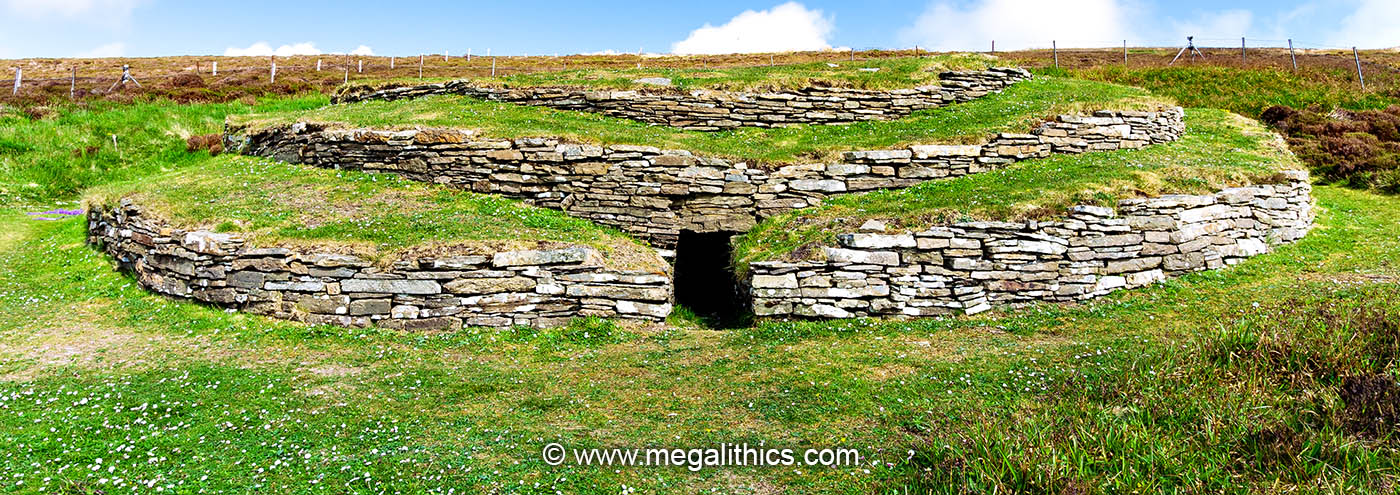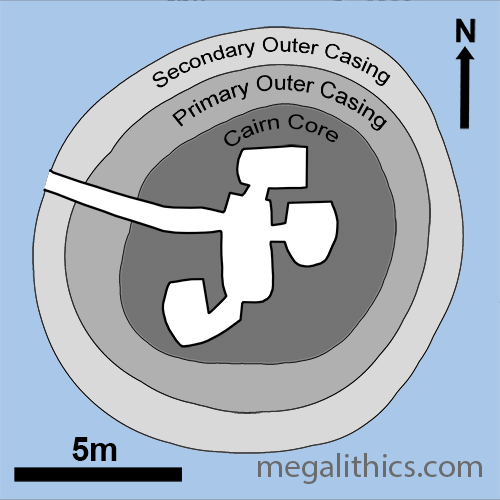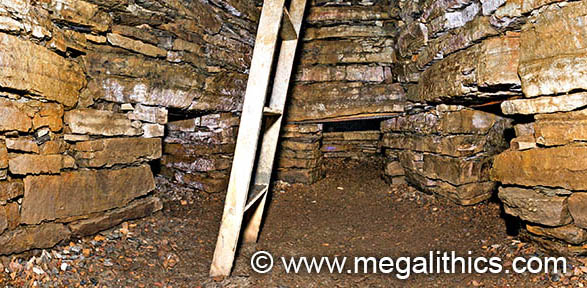 |
| HY 40909 12090 (GPS 20min by top hatch) | Diameter - 14.5m E-W x 13.5m N-S (Pub.) |
| Visited June 2008 | Alt.127m OD (GPS) |
 |
Wideford Hill (ORK 54), is a Maes Howe type cairn in a good state of preservation built into the western slope of Wideford Hill on Mainland Orkney. The site is around halfway up the hillside (we measured the elevation at 127m OD), and there are beautiful panoramic views from the site over to the Bay of Firth and the islands of Damsay and Holm of Grimbister.

PUBLICATIONS AND EARLY ACCOUNTS
Although Petrie first excavated Wideford in 1849 he did not publish a full account of this. Most detail of Petrie's excavation is found in Thomas' accounts of Petrie's communications with him, described in his work on "the Celtic Antiquities of Orkney"(1) which also includes a detailed plan diagram of the cairn. Although printed in 1852, the paper was read to the Society in February of 1851.
Petrie was not the first to attempt entry to the cairn, he noticed signs of an earlier attempt that was "abandoned after an excavation of about a couple of feet in depth had been effected". The cairn was a turf-covered conical mound before opening and Petrie's workmen dug a "cut, six feet in breadth, upon the north side". They first discovered the intact roof stones of the eastern side-chamber, which delighted Petrie as he could now identify the building - " It was now evident the structure was of the description so generally known by the appellation of a Picts house."
At the time, there was a rough demarcation for Scottish ancient chambered stone structures, completely subterranean structures called "Weems" (known as Souterrains today) and above ground structures that were known as "Picts' Houses" (Chambered Cairns, today). Being partly built into the hillside there was a possibility that Wideford could have been a Weem, but once Petrie saw the internal structure, he knew he was dealing with a Picts' House.
The roof stones and part of the walling of the eastern chamber was removed to allow a workman to explore, the doorway communicating with the main chamber was found but was "so blocked up with stones and rubbish that the man could not get into it." So digging was continued on the main body of the cairn. After an hour or two the southern roof stone of the main chamber was uncovered and removed, and the space explored. The main chamber was found to be "nearly full of stones and rubbish" and when this was cleared out the internal structure that is visible today was revealed.
A few of the features described by Petrie are not visible today, most notably a passage running east from the SE corner of the northern side-chamber. Petrie revisited the cairn at a later date to investigate this feature concluding "The passage to the eastward appears never to have been completed, as it only extends for six or eight feet, and then terminates.". Both versions of Thomas' map show this passage ending as it meets the bedrock of the hillside where the hill was excavated to accommodate the cairn. Petrie seemed convinced that this passage was a real structural element of the cairn and both plans show it was at least 2.5m long. The original hole in the wall of the side-chamber has been made good so the "passage" or its entrance cannot be examined today. As every other doorway in the cairn was constructed with a huge lintel stone to bear the weight of the cairn above, and there is no sign of such a stone in the walling today (see photo below), we suspect that the "passage" was probably damage to the walling revealing a void behind.
Another feature reported by Petrie that does not match the current state of the cairn is roofing. Petrie describes the roofing of all of the side-chambers as being roofed by "stones placed on edge" and the chambers all seem to have flat capping slabs at present; confusingly, in both versions of Thomas' map, the sections seem to show all of the side chambers capped by flat slabs. Henshall states that the capstones of the north and south side chambers are original and that the capstone of the east chamber, which was removed by Petrie has been replaced, all are flat laid slabs. The main chamber roofing was of "stones set on edge, and lying flat alternately", so the current roofing is certainly all modern replacement.
As well as the alternating stones, the main chamber roof had a curious central "chimney" structure, Petrie describes this as "having an opening (i) at its top extending about twenty-one inches higher" (than the roof stones). From the diagrams, it appears this feature was formed of cairn slabs built upon the roof stones, Petrie describes it as being "covered at its upper extremity with the layer of turf". He thought that there may have been a now-vanished structure above the cairn, the debris of which had fallen through the hole and partially filled the main chamber below.
Wilson's book of 1851, The Archaeology and Prehistoric Annals of Scotland (2), also relates Petrie's description of his excavation and a version of Thomas' map is included, but this is modified and missing some of the labelling. There is essentially no further information on Petrie's excavation over that provided in Thomas' work, but the intended purpose of the structure is discussed. Wilson was certain that the "Picts' Houses" were not mortuary monuments "Nothing found in this or any of the previously explored "Picts' houses" gives the slightest countenance to the idea they were designed as places of sepulture". He was convinced that the structures were dwellings and this idea leads to some quite amusing comments, he was particularly dismayed by the "extremely circumscribed dimensions of the passages... so that entrance could only be obtained by crawling on the ground". This situation leads him to have a rather low opinion of the builders " the arrangement affords a very striking confirmation of the barbarous state of the people, who were yet capable of displaying so much skill and ingenuity in the erection of these cyclopean structures."
In 1863 Petrie (3) briefly mentions his excavation of Wideford Hill in a general discussion on the form and nature of "Picts' Houses". He also mentions the inclusion of the account of his excavation in Wilson's book.
Kilbride-Jones re-excavated Wideford in 1935 but did not publish any details of this work until 1973 (4).
Henshall covers Wideford Hill in her magnum opus of 1963 (5) publishing a plan and section. Her coverage is later expanded in her excellent work on the Orkney chambered cairns (6) in 1989.
DESCRIPTION
Orkney has two main types of chambered cairns, Orkney-Cromarty (O-C), and Maes Howe (MH), Wideford Hill is a member of the latter group. Over fifty O-C cairns are known in the Orkneys, but there are only ten known examples of MH cairns, and five of these, including Wideford, are found in one narrow strip of Orkney Mainland.
The Cairn and Passage
Wideford is a round cairn, almost circular, measuring 14.5m N-S and 13.5m E-W. The cairn has a structure comprised of multiple concentric layers that is typical for many Maes Howe type monuments (see diagram above), these layers are distinct components separated by substantial wall faces. The inner cairn core, which contains all of the chamber structure, is about 7.7m in diameter, this is surrounded by the the primary outer casing which is 10.4m in diameter and this is surrounded by the secondary outer casing at about 12.9m across. The cairn structure has been built into a cut-out in the hillside, so the foundations of the walling layers at the east of the cairn are almost 3m above those of the facade at the west.
Today, the three component layers of the cairn have been left exposed and the structure is obvious, creating a "squashed wedding cake" shape. The original finished form of the cairn is unknown, one school of thought suggests a smooth domical cairn, another, a drum shape with a smoothly domed top, but there is no evidence to support one or the other.
The main fabric of the cairn is thin flat slabs of stone laid horizontally, this is evident in the exposed wall faces on the exterior, but excavation found that the fill between the wall faces was of similarly carefully laid stones, and not the more usual stone rubble. Kilbride-Jones (4) found part of the roofing of the central core intact, this consisted of thin wide slabs laid in an overlapping "diamond pattern" which sloped downwards from the cairn centre to the edge of the cairn core. Presumably this was intended to limit water ingress, indeed, Kilbride-Jones describes them being "like very large slates".
The passage opens at the WNW and is 5.3m long and is 50cm wide at each end but swells to 70cm about 3m in, where it also turns slightly to the north. The passage is currently roofed from the cairn core to the outer walling of the primary outer casing, it is not clear if the roofing originally extended further out into the secondary outing casing. Roofing consists of nine large slabs laid flat around 60cm above the floor. The passage entrance into the main chamber is supported by a particularly massive lintel stone, this has cracked in the centre and is now reinforced with steel bars. We measured the orientation of the outer passage section at 290 degrees true.
Chamber and side cells

The main chamber is roughly rectangular and around 3.0m by 1.4m at floor level, there are doorways in all four walls, one in the west wall for the entrance passage, and in the other three walls for the side cells. The walls all corbel in gradually and by the original roof height of 2.4m the width of the gap is reduced to only 0.5m where it was spanned and roofed by "stones set on edge, and lying flat alternately"(1). Petrie found a hole in the centre of the roofing with an unusual "chimney" structure built around it up to the top of the cairn stonework, where it was only covered by a layer of turf. The "chimney" has been replaced by a modern hatch which is now used by visitors to access the cairn interior, all of the other roofing is modern replacement.
The stonework of the walling is of good quality and there are some very large stones incorporated, especially the lintels of the doorway openings, and both of the end walls consist of full-width stones for much of their height. There are doorways to side cells in the SW corner, north wall and east wall, these are very similar in dimensions to the passage portal in the west wall, about 60cm tall and 40-60cm wide. The side cells have irregular shapes and are all around 2m long and 1.3-4m wide, roof heights vary between 1.9-2.2m. Although appearing very substantial when viewed on site, the walls of the cells are only one stone thick where they adjoin the main chamber. The cell walls all corbel in and all create a rectangular section up to where they are capped by single flat-laid slabs. Petrie described all of the side cells being roofed by "stones placed on edge", this does not fit with current arrangement (or Thomas' drawing) and Henshall states that the north and south cell roofing of flat slabs is original.
Despite the care taken to inter-fill and consolidate the fabric of the walling layers of the cairn structure it seems that some spaces between the cells and the rockface of the hillside on the eastern side were left empty as Petrie thought that there was an opening and a passage running some "six to eight feet" east from the northern side cell. The walling of this cell has been made good, so no trace of this is visible today (see photo above) and there is also no sign of the massive lintel that would have been installed above a genuine doorway. How and when the hole in the side cell wall was made is unclear, as the rest of the internal structure appears to have been intact during Petrie's excavation.
Neither Petrie or Kilbride-Jones report any finds from the cairn.
VISITING
The cairn is open for visiting all year round. The approach from the nearest parking is 600m via a rough path over very sloping ground, and access to the chamber is via a fixed metal ladder through a small opening in the original roof of the main chamber, so it is effectively inaccessible for folk with significant disabilities.
The roof opening is covered by a pull-off hatch, and as we found at several other Orkney cairns, a torch is thoughtfully provided in a wooden box near the cairn so that even ill-prepared visitors can examine the interior. The chamber is floored with gravel through out and you will be down on hands and knees if you wish to enter the side cells; the entrance passage is blocked by a metal grille at the outer end, but you can access the full length of it (we did!) from the main chamber if so inclined.
Despite the access problems, the sheer rarity of Maes Howe type cairns and the excellent level of preservation of Wideford makes it a Must Visit for the megalithically inclined.
1.
Thomas, F.W.L., Archaeologia 34, p124-7, pl15, 1852.
2.
Wilson, D. "The Archaeology and Prehistoric Annals
of Scotland" p84-6. Sutherland and Knox, 1851, Edinburgh.
3.
Petrie, G., The Archaeological Journal, 20, p.32-7, 1863.
4.
Kilbride-Jones, H.E., Acta Prehistorica et Archaeologica, 4, p.75-96, 1973.
5.
Henshall, A. S.,
The Chambered Cairns of Scotland,
p.245-6, Edinburgh University Press, 1963,
Edinburgh.
6.
Davidson, J. L. and Henshall, A. S., The Chambered
Cairns of Orkney, p.169-70,
Edinburgh University Press, 1989, Edinburgh.